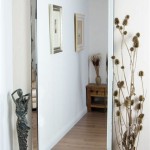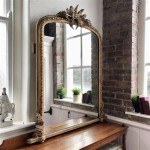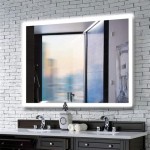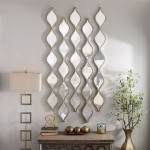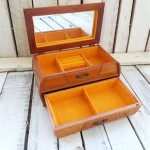How to Attach a Framed Mirror
Attaching a framed mirror securely and safely requires careful planning and execution. The appropriate method depends on the mirror's size, weight, and the wall's construction. This article outlines different approaches for achieving a professional and lasting result.
Using D-Rings and Wire
This traditional method works well for medium-sized framed mirrors. It provides a stable hanging point and allows for minor adjustments during installation.
- Attach D-rings to the back of the frame. Ensure they are evenly spaced and level.
- Measure and cut a length of picture wire. It should be slightly longer than the distance between the D-rings.
- Thread the wire through each D-ring, securing it with a double knot or wire clamp.
- Measure the desired hanging height on the wall and mark the location.
- Install the appropriate picture hook or wall anchor at the marked location. Ensure the hook is rated for the weight of the mirror.
- Hang the mirror on the hook, ensuring the wire is securely seated.
Utilizing French Cleats
French cleats offer a robust and secure method, particularly suitable for heavier framed mirrors. The interlocking design provides strong resistance against vertical and lateral forces.
- Acquire a French cleat system. These typically consist of two interlocking pieces of wood or metal, one attached to the wall and the other to the frame.
- Attach the cleat designated for the wall to the desired location. Ensure it is level and securely fastened using appropriate screws or anchors.
- Attach the mating cleat to the back of the mirror frame, ensuring it aligns with the wall cleat and is level.
- Carefully lift the mirror and engage the two cleats. The angled design will create a secure and flush mounting.
Employing Mirror Adhesive
Mirror adhesive offers a straightforward approach, especially for lighter mirrors and smoother wall surfaces. It eliminates the need for visible hardware but requires meticulous application.
- Ensure the wall surface is clean, dry, and smooth. Remove any dust, debris, or loose paint.
- Apply the mirror adhesive to the back of the frame according to the manufacturer's instructions. Typically, this involves applying adhesive in vertical lines or a grid pattern.
- Carefully position the mirror on the wall, applying even pressure across the surface.
- Support the mirror with temporary bracing or tape until the adhesive fully cures. The curing time varies depending on the adhesive used, so refer to the manufacturer's instructions.
Mounting with Z-Clips
Z-clips provide a concealed hanging method, ideal for a sleek, minimalist look. They consist of two interlocking pieces, one attached to the wall and the other to the back of the frame.
- Attach the Z-clips designated for the wall to the desired location. Ensure they are level and securely anchored.
- Attach the mating Z-clips to the back of the mirror frame, aligning them with the wall-mounted clips.
- Carefully hang the mirror by engaging the interlocking parts of the Z-clips.
Considering Mirror Mounting Clips
Mirror mounting clips provide a secure solution for heavier mirrors and offer some adjustability. They are typically installed along the bottom and sides of the frame.
- Determine the placement of the clips on the wall based on the size and weight of the mirror.
- Securely attach the clips to the wall using appropriate screws or anchors.
- Carefully place the mirror into the clips, ensuring it sits securely in place.
- Adjust the clips as needed to ensure the mirror is level and flush against the wall.
Addressing Wall Conditions
The wall's construction plays a crucial role in selecting the appropriate mounting method and hardware. Drywall requires different anchors than concrete or brick.
- Identify the wall type: drywall, plaster, concrete, or brick. This determines the type of anchor or fastener required.
- For drywall, use hollow-wall anchors, toggle bolts, or molly bolts for heavier mirrors. For lighter mirrors, standard screws might suffice.
- For concrete or brick, use masonry anchors or concrete screws. Ensure the appropriate drill bit and pilot holes are used.
Safety Precautions
Safety is paramount when working with heavy objects and wall-mounted installations. Taking necessary precautions prevents accidents and ensures a successful outcome.
- Wear appropriate safety gear, including gloves and eye protection.
- Enlist assistance when handling large or heavy mirrors.
- Use a stud finder to locate wall studs for added support when possible.
- Always follow the manufacturer's instructions for adhesives, anchors, and other hardware.

How To Frame Out That Builder Basic Bathroom Mirror For 20 Or Less

How To Frame A Mirror Sand And Sisal

3 Ways To Frame A Mirror Wikihow

How To Add A Frame Your Bathroom Mirror

How To Frame A Bathroom Mirror

3 Ways To Frame A Mirror Wikihow

Bathroom Mirror Frames 2 Easy To Install Sources A Diy Tutorial Retro Renovation

How To Hang A Frameless Mirror On The Wall With Pictures

How To Build A Mirror Frame Simple Woodworking

The Kids Bathroom Mirror Gets Framed House Of Hepworths



